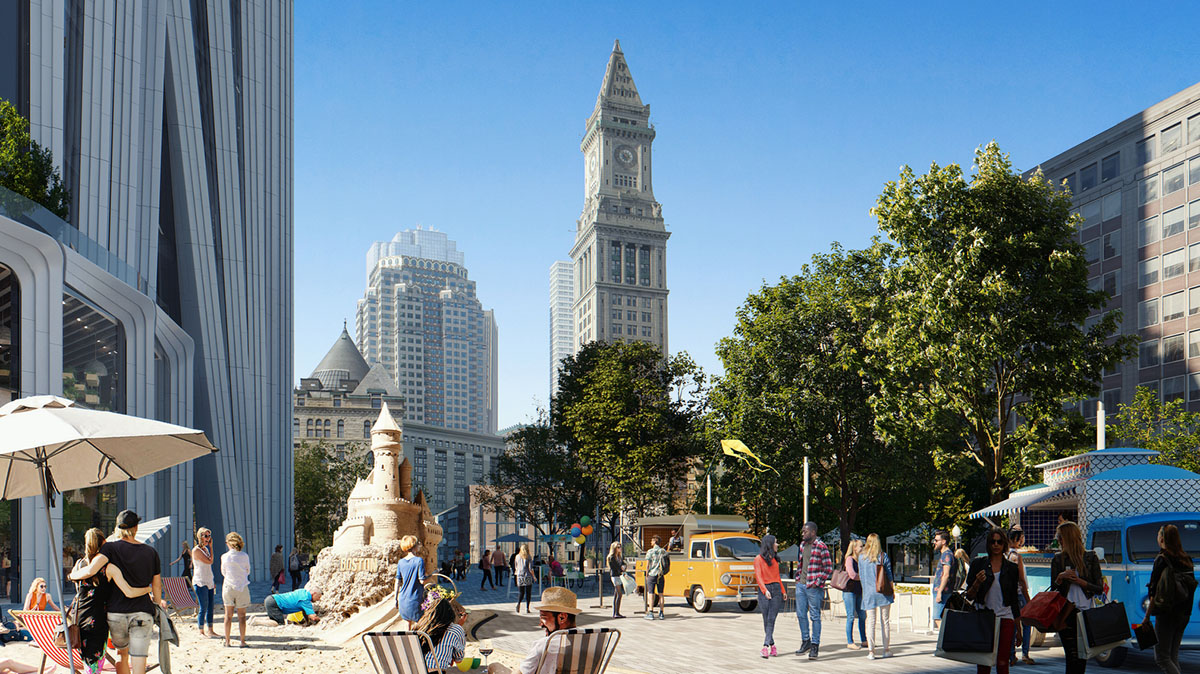Submitted by WA Contents
KPF reveals its high-performance and resilient mixed-use tower in Boston
United States Architecture News - Jan 31, 2020 - 10:52 12160 views

KPF and the Chiofaro Company have unveiled design for a high-performance and resilient mixed-use tower on the Boston Harbor waterfront.
Called The Pinnacle at Central Wharf, the new 83,612-square-metre tower will replace a 7-story parking garage that occupies the entirety of its site, The Pinnacle will give half of the previously inaccessible area over to public open space.
As KPF states, the tower will reconnect Downtown Boston to the waterfront with new public space, and advance the Climate Ready Boston initiative through significant sustainable and resilient design elements.

The building, comprised of sliced vertical elements, incorporates innovative design strategies pertaining to climate resiliency, energy, emissions, water, and materials to minimize its environmental impact, protect infrastructure, and improve the health and wellbeing of the community it serves.
The tower's façade is textured with scaled materiality which is expressed in strong vertical elements, and that folds at the tower’s peak to provide solar shading and natural ventilation in the residential portion of the tower.

"For The Pinnacle at Central Wharf, we worked hard to create a form that responds to the city of Boston," said Design Principal Trent Tesch.
"The building’s elegant rounded composition steps back in a series of scaled stacked volumes. Its massing is emphasized by the façade’s simple vertical expression, which also diffuses sunlight and wind for a more comfortable experience at the ground plane. Dramatic openings at the base activate the area’s newfound public space, and participate in a contextual dialogue of entry along Atlantic Avenue and the Rose Kennedy Greenway."

"KPF has been working with The Chiofaro Company at this site for many years. Through the project’s several iterations, the constant theme has been a generous response to the urban fabric with a goal to create a building that is an architectural model of resiliency and sustainability," said Managing Director Jorge Mendoza.
"We’re proud of the resulting scheme for The Pinnacle, and are grateful for the efforts of the City of Boston and all of our collaborators."

KPF's Boston Harbor Tower creates new public space
The Pinnacle’s orientation on the site will enable a new pedestrian corridor, designed to integrate with the New England Aquarium’s proposed “Blueway” vision, to connect the waterfront to 28,000 square feet (2,601-square-metre) of on-site active public space, the Rose Kennedy Greenway and Downtown Boston, inspiring a diverse cross-section of visitors to the waterfront. The tower’s lower-level public amenities, including extensive retail, will line a dynamic plaza, with year-round programming activating this new destination.
Additionally, The Pinnacle will be the first Downtown Waterfront project to implement Boston’s new climate conscious development mandates. The project site, as well as the Harborwalk adjacent to the site, will be elevated four feet above its present grade and seamlessly connect with neighboring sites as they make similar adjustments in the future.

These changes will provide a reimagined waterfront for Bostonians that will focus on reducing inland flood risk, protecting billions of dollars in property and infrastructure and enhancing walks along the harbor, while also accommodating lively outdoor activities that will draw residents and visitors to the water’s edge.

The tower sets sustainability and resiliency strategies
Sustainability and Resiliency Based on the current target credits, a LEED Gold rating is anticipated for the project, which will be achieved through a holistic approach to sustainability with close collaboration between KPF, The Chiofaro Company, and consulting teams. Considered efficiency measures include a high-performance envelope, high-efficiency mechanical and ventilation systems, and low-flow and low-consumption plumbing fixtures.
The project may also include cross laminated timber decking, solar photovoltaics, combined heat and power energy generation, and rain and grey water reuse systems. To assist with the design process, KPF’s Environmental Performance team (KPFep) developed early design energy models to analyze energy conservation scenarios, as well as shadow, glare, pedestrian wind comfort, and internal daylighting.

"Designed to present a distinct and powerful image on the skyline while being respectful of the existing context, the tower’s curvilinear form will reduce shadow impacts and ease pedestrian flow around the building’s base, creating smooth circulation paths and opening view corridors to the water," said KPF in its description.
"This massing will further enhance pedestrian comfort by mitigating potential turbulent wind from the water. As the tower rises, setbacks provide outdoor terraces for occupants and visitors, with views to Boston Harbor and Downtown."

The glass curtain wall is also treated with a non-reflective coating to minimize the glare to the neighborhood. Grand gestures signal entry points in the podium, where vertical piers peel apart to reveal a special façade expression, and serve as markers, with the tallest and largest opening at the office lobby facing the Greenway.

US firm Kohn Pedersen Fox Associates (KPF) was founded by A. Eugene Kohn, William Pedersen and Sheldon Fox in 1976 in New York. The firm now consists of over 650 employees led by 30 principals, with offices in New York, London, San Francisco, Shanghai, Hong Kong, Seoul, Abu Dhabi, Berlin, and Singapore.
KPF's casino-hotel-resort, comprised of stacked jewel-like boxes, recently won the Emporis Skyscraper Award. The firm is also working on a new spiraling tower in Tel Aviv, which will be the tallest building of Tel Aviv upon its completion.
All images © KPF
> via KPF
